Last year we reviewed the Solar Bluetooth GPS receiver from F-Tech. Back then the receiver had a weirdo 8 Channel Xemics chipset that was both low power and low performance. But the device deserves the credit for being the first commercially available solar BT GPS.
Technology has moved on, and we now have a much bigger choice of Solar receivers. F-Tech have upgraded their original model with a SiRF III chipset version and a MediaTek MT3 chipset version (both called 2.3 Series). They have also brought out a smaller receiver, dubbed the mini-Solar (or 2.5 Series), also with a choice of SiRF III and MediaTek MT3 chipsets.


Here we will review the SiRF III version of the 2.5 series mini-Solar (provided by BuyGPSnow.com, on the right) and we will compare it with a very interesting variation on the theme - the Transystem i-Blue 757 (MT3 chipset version, in the middle).

What good is a Solar BT GPS receiver? Let's leave the meteorological aspects out of the discussion for a second, and focus on the general usability.
The solar cells on these receivers are not yet powerful enough to power the unit completely. Chipset power consumption is fluctuating, it has increased with the initial SiRF III chipset, and decreased again with the Low Power SiRF III version and with the other chipsets. But generally the solar cell can only provide about a third of the required current, and only with sufficient sunshine.
So a purely solar driven GPS is not yet ready for permanent operation. It is however well suited for the occasional usage, and for being held "on the ready" in case you need it. The real benefit of the solar cell is the "top off" capability for the integrated battery. Most of the time you know the area where you are driving, and you can leave the receiver in the car, somewhere on the dash for example, to catch the sun during the day hours. And if you need the GPS for navigation it will be sufficiently charged and will be able to provide service for longer time intervals.
Just how long? We are doing the regular tests on longevity of a GPS receiver under pretty nasty conditions - each receiver is placed behind tinted double glass in a high rise building that is surrounded by other high rises (so the direct view of the sky is about 5%, and the reflections and multipaths are plentiful). The receiver's NMEA output is logged to VisualGPSxp, from a fully charged battery to the very end when the NMEA stream stops. We then take the time difference, and repeat the whole process a few times to ensure the battery is well conditioned. Here is an example for the 757.

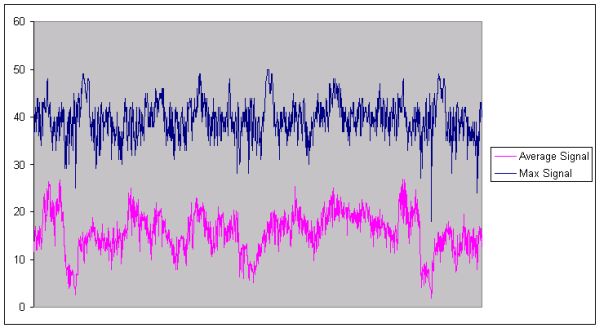
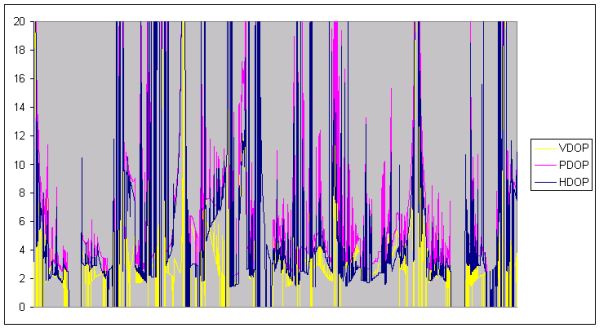
Just to re-emphasize - this data is collected from a receiver that has not got a fair chance to get and hold a fix. It was sitting behind coated glass, with very little sky view. The green graph on the top is the fix type. 3 means 3D, 2 means 2D, and 1 means no fix. Given these circumstances the 757 has shown a very impressive performance. Oh, did we mention already that the whole cycle represented here lasted 1810 minutes (from a single charge!) ?
Actual real life performance of the receiver (sitting on the dashboard of my car) was flawless. It always locked on very quickly after the BT connection was established, and maintained a very comfortable 3D fix.
The results above will also help you decide if it is possible to operate the GPS without ever needing to charge it off the car's cigarette lighter or off a mains adapter. For my driving habits (and insolation levels) this works out very nicely, your mileage may vary.
Let's have a closer look at the receivers.
Transystem iBlue-757

The Transystem i-Blue 757 has a rather unusual clamshell design. The upper part contains the GPS antenna while the lower part houses the solar cell, the battery, and the circuitry. Note the Mini-USB charging connector on the left. When connected to a computer a CP2102 Serial-to-USB bridge is reported but even after installing the drivers on the PC no data is transferred through the USB connection.
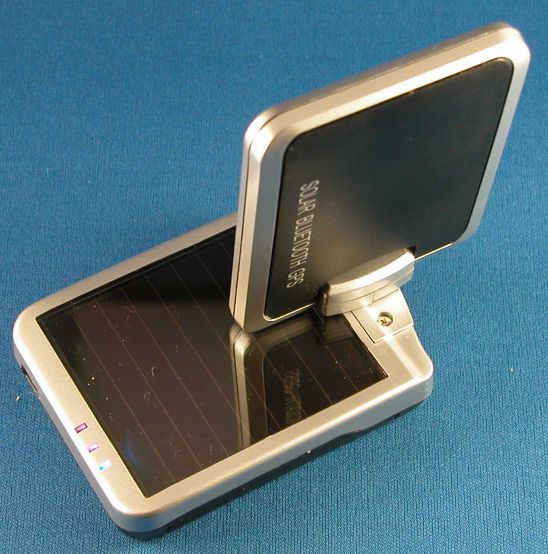
The upper part can not just flip open, it also swivels around 270 degrees. The obvious question is - what does this rotation do to the RF cable that connects the GPS antenna to the circuit board?
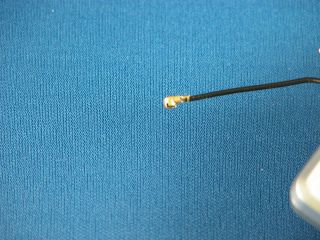
It's a tiny cable, and I had my doubts if it can handle all the twisting and bending. However, the path of the cable is pretty ingenious inside the tilt-swivel mechanism, and contortions of the cable are reduced to a minimum.
In the middle between the two encapsulated rectangles you can see the minute antenna connector, on the left is a MMCX connector for an external antenna. Given the receiver's sensitivity you won't need that external antenna except for really bad locations, like in a RV with overhanging roof.
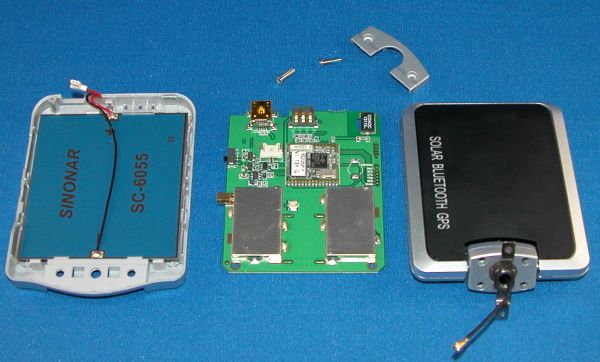
Here most of the device is shown, the solar panel to the left and the GPS antenna to the right. You can see how the antenna cable is guided through the middle of the tilting mechanism.
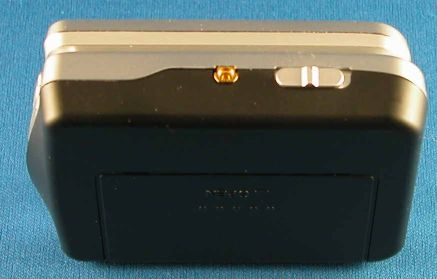
The side of the receiver sports the already mentioned MMCX connector and the On/Off switch. On the left you see the "bulge" caused by the tilt-swivel mechanism. The bottom has the battery compartment. It also sports two design oddities - the raised text on the compartment door prevents the unit from lying flat. It will always wobble just enough to annoy you. The other oddity is the absence of anti-skid measures. Rubber feet may not look sexy but they do have a purpose, especially when the receiver is placed on the dash of the car.
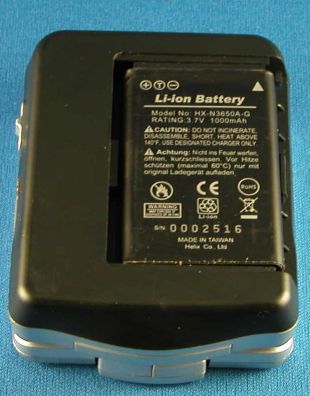
The battery is a standard Nokia style battery, with a 1000 mAh capacity. So if you really, really want to be on the safe side you can carry a spare Nokia battery.
The one other gripe I have with the iBlue-757 is the design decision to put the GPS receiver into the upper half and the solar panel into the lower half.
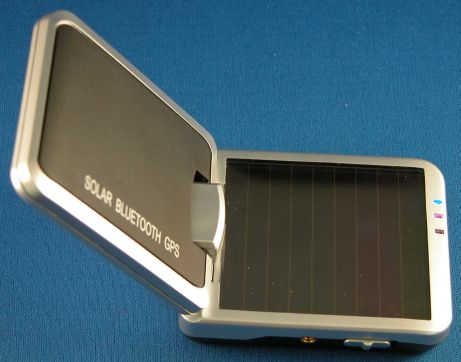
In my understanding this should have been the other way round - the solar panel should be positionable towards the sun, and the GPS antenna should rather lie flat to get the optimum GPS signal.

The centre of gravity is - due to the battery - on the solar panel side, and the bulge doesn't help either. So the above position is not overly stable in itself. But maybe you can find a place in the car where the solar panel can be oriented towards the sun while the car is stationary.
Do not expect the solar panel to charge the receiver's battery while your car is in motion (unless you are driving hundreds of miles in a straight line or are rearranging the solar panel all the time). Charging will have to happen while the car is standing around idle, in front of the shop, in a car park, at the train station.
What about thefts? Yes, that may be a problem. But if you tilt the upper cover so that the words "Solar Bluetooth GPS" are not readable the device could be mistaken for an odd solar cell. Maybe that will make it less likely to be forcefully removed?
When you are walking the hills this may be less of a problem. You can fasten the receiver to the outside of your back pack (there is no lanyard loop, but you could place the receiver into a plastic bag or similar) and let it charge the battery while you are walking.
What's in the box?
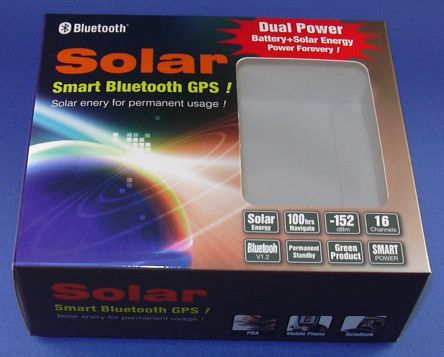
The box is nice and shiny and has some interesting slogans. I'll let you find the gems yourself.
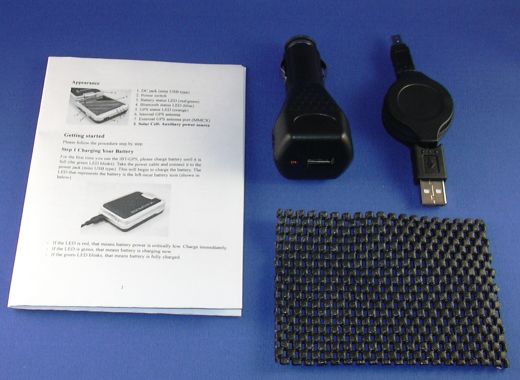
You get the receiver, a little leaflet describing the Bluetooth pairing process and the function of the LEDs, and a mobile charger consisting of a cigarette lighter USB adapter and a USB-mini USB retractable cable that you can also use with your notebook or desktop (unfortunately only to charge the device). The anti-skid mat is a bit on the ugly side but it does the job, particularly since it needs to compensate for the slippery bottom of the receiver.
No mains power supply is provided, and it also doesn't seem to be necessary given that the receiver clearly wants to live in the car.
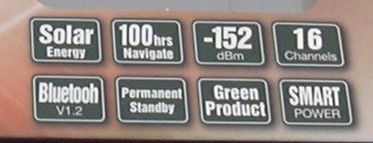
Let's quickly go through the main claims on the box.
Solar Energy - check. Nice big solar panel.
100 hrs Navigate? This probably depends on how you measure it. Under full load without solar panel support the receiver manages to run for 30 hours 10 minutes - still very impressive I would say.
-152 dBm - yes, kinda sorta. On par with SiRF III, not as good as the iBlue-737 though.
16 channels - check, useful for multipath environments
Bluetooh? Nope, but Bluetooth is available and working flawlessly
Permanent Standby - Now this is a very, very smart feature. At the expense of an itsy bitsy consumption of battery power the Bluetooth stack on the i-Blue 757 is kept alive even when no connection is active. As soon as your PocketPC or Smartphone or Notebook establish a Bluetooth connection the 757 will wake up the GPS receiver part, and thanks to the chipset's sensitivity will regain a fix within a few seconds. Once the Bluetooth connection is terminated the GPS module goes back to sleep.
Green Product - check, the device is built according to the RoHS standards.
Smart Power - same thing as Permanent standby. Not sure why this is mentioned again.
For reference here are the specs of the i-Blue 757 (from the Transystem website)
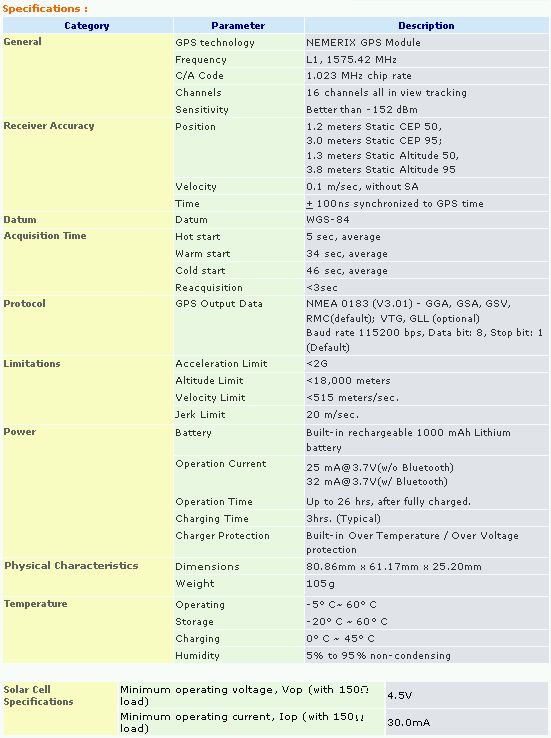
F-Tech Solarius
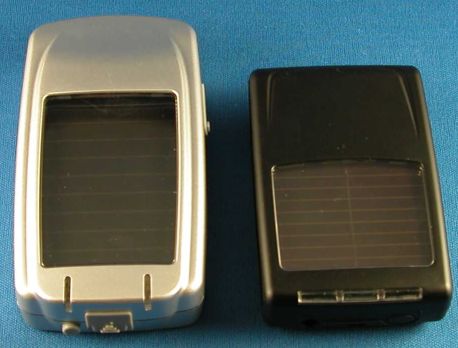
The new F-Tech receiver v2.5 (on the right) is quite a bit smaller than the older v2.3 and Generation 1 model. Unfortunately this also means the solar panel is smaller - not exactly a good thing.
The other interesting thing is that the F-Tech 2.5 has a round, iPAQ style power plug - a step back from the first generation model that already had the now ubiquitous mini-USB socket.
A lanyard loop has been added to the device case so you can attach or fasten the receiver to yourself or your bicycle or backpack etc. This is a small design detail but something that I always value highly, because it shows the "commodity" quality of a product and it is just plain practical.

The first generation F-Tech had a magnet under the rubber pad, and could be affixed to car roofs etc. The 2.5 unfortunately no longer offers a magnet on the underside of the case. But it has the anti-skid rubber feet which actually work better than the original flat pad.
Apart from that there are chipset changes, and they are for the better. Both the SiRF III and the MT3 chipsets perform much better than the old Xemics chip. The MT3 has the better battery runtime since it consumes 30% less power than the SiRF III. Here's the tech speak from the F-Tech website.
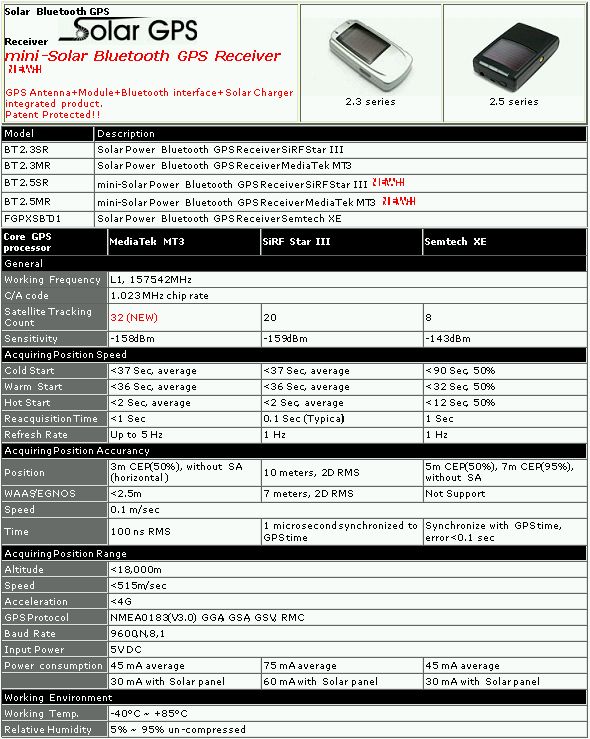
The F-Tech 2.5 has basically the same controller board like the first generation model (minus the GPS chipset of course). So it also sports a auto-switchoff after 30 minutes of no BT traffic. It also seems to switch off after that time if the receiver is not moved. That is the reason why I cannot show conclusive performance data for this receiver - it kept switching off during the test (It probably just got fed up with sitting on a windowsill behind thick coated glass and not going anywhere. Who could blame it). I have not seen that happening while the receiver was used in the car.
What else is there on the market?
If you can't warm up (hehe) to the idea of a solar GPS receiver, how about a solar charger? They can be used for more than just the GPS, they can charge your mobile phone too if needed.
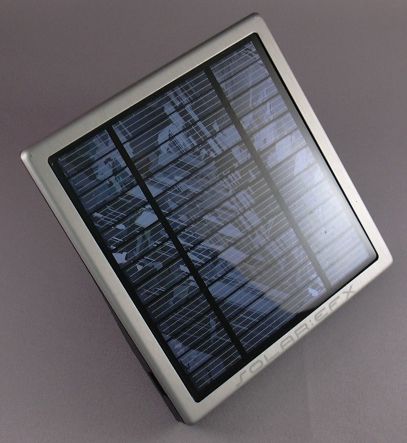
The best accessory for this that I have found so far is the Solar EFX (Made in the UK, by the way). It has a sturdy case, a nice big panel, and a buffer battery. This makes it the ideal emergency charger that you can just have with you on the trip, let it look at the sun if available, and when needed it can give you that crucial three minute talk time, or a position fix to figure out where exactly you got lost.
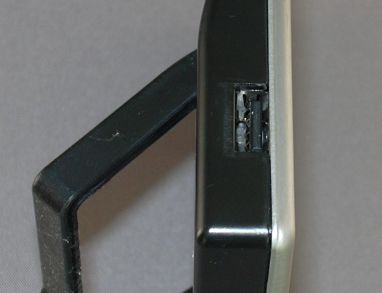
The best thing on the Solar EFX is the connector - it has a standard USB port, and can therefore charge any device that normally plugs into a PC. Brilliant! In the picture above you also see the bulge (because of the battery) and the feeble back stand to adjust the panel towards the sun.
Conclusion
The Solar Bluetooth GPS Receivers have arrived. Last year they were a novelty technology (technology is stuff that doesn't yet work right), this year they are a commodity (stuff that just works). The solar panel does extend the battery life, and definitely prolongs the intervals between mains charges, under good weather conditions even substantially. As I predicted in my last review we're getting very close to self-sufficient devices that never (well, nearly never) need to be charged.
The GPS performance has improved dramatically from previous devices. The MT3 chipset can compete with SiRF III on eye level, and has the advantage of lower power consumption.
The iBlue-757 is a technically very attractive device, with good GPS sensitivity and fantastic battery runtime. In addition it supports Permanent Standby mode which saves power when no GPS data traffic is needed, yet also allows to reconnect in a few seconds once the data connection has been re-established.
The F-Tech Solarius offers a solid SiRF III performance, with very acceptable battery runtime, but obviously it is not as fancy as the iBlue. Both devices can be recommended for in-car use but also - and more fittingly - for outdoor activities away from a power source.